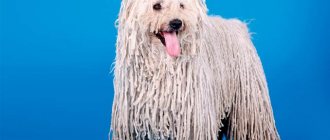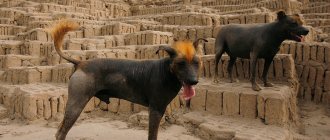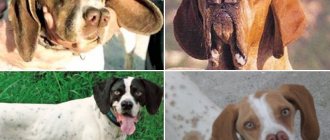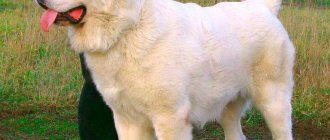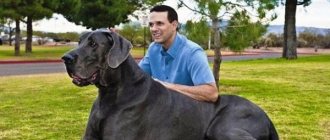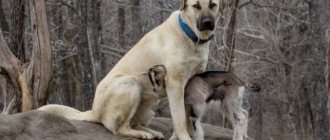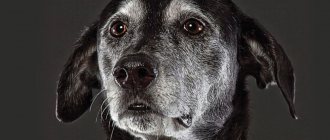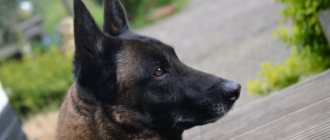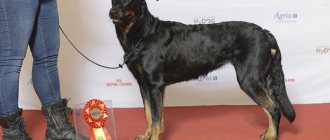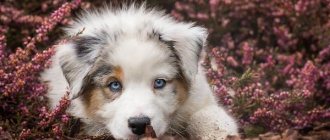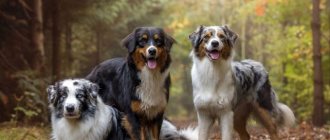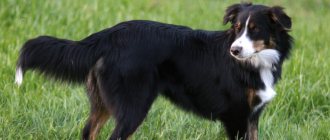Breed characteristics
| Short description | |
| Origin: | Hungary |
| Conditions of detention: | In a house with a small or large garden |
| Purpose: | Herding dog, guard dog, companion dog |
| Color: | White |
| Wool length: | Long 27-30 cm |
| Adult dog size: | The height of females is 65 cm, males 70 cm, weight of males is approximately 50-60 kg, females - 40-60 kg |
| Average life expectancy: | 10-12 years |
| Walk: | If there is not enough space, at least 2 times a day, if the dog lives in the yard, once is enough |
| Physical activity needs: | Average physical activity needs (walking 1 to 3 hours per day) |
| Fédération Cynologique Internationale (FIC) classification: | Group 1: herding and cattle dogs, section 1: shepherd dogs |
| Puppy price: | 35000-70000 rubles |
Nutrition
Mudi is a dog that is unpretentious when choosing food; it can eat from the owner’s table, but this should not be abused. The food a person takes may be poorly digested and cause heaviness in the pet’s stomach.
For a dog, it will be enough to eat 2 times a day, without overeating. If your dog hasn't emptied the bowl within 20 minutes, you can throw away the leftovers and add a smaller portion size to the next meal.
Mudi does not need to be fed fatty foods; try to maintain a balance of nutritional components in natural food. When using dry food, you need to ensure that it contains fewer chemicals.
History of the origin of the species
This breed is considered one of the most ancient. It has not been subject to selection and is practically original. According to the official version, which is followed by experts, the Komondor appeared due to the crossing of a wolf and herding dogs. This can be proven by the “wolf” habits and character of the dog.
They came to the territory of modern Hungary together with the Magyar tribes, who were expelled from the southern lands by the Khazar Kaganate. Some sources indicate that shepherd dogs were found in Russia. One way or another, the nomads used dogs exclusively as workers and did not cross them with other breeds . White curly wool helped the dog to camouflage itself among the sheep and, if threatened, to attack the enemy. Komondors did not herd livestock, but only performed a guard function.
There are several legends relating to this breed. One of them says that Hungarian Shepherds are the fruit of forbidden love between a sheep and a wolf. Another myth tells of two hunters who tamed wolf pups. The dog was called "king" because it was not like other domesticated pets.
The first official historical documents that mention Komondor are books:
- 1544 “The History of the Ruler Astyagis” by Peter Kokony (tells about dogs with sheep’s wool);
- 1650 notes by Amos Comenius (the Hungarian Shepherd is described as a good shepherd and guard);
- 1778 Michael Klein (meeting with sheep-like dogs).
The standard for the breed was written in 1924, when it was recognized by the kennel club . In the post-war period, József Bukowski was involved in restoring the population; he bred not only white shepherds, but also colored ones. One way or another, all colors except light are considered incorrect.
Now Komondors are good companions and guards, they are quite popular, despite the fact that the number of dogs is not that large (10-12 thousand individuals)
Purpose
The historical function of the Hungarian Shepherd breed is considered to be herding and guarding cows and sheep. The four-legged animals did an excellent job with this job.
Owners could leave entire herds with them without worrying about their integrity. Hundreds of years later, Komondors have not lost their historical purpose; today they protect local territories.
Distinctive features
Hungarian Shepherds look extraordinary. Not only do they reach 70 cm at the withers , but their thick, unusual coat adds volume to the dog. The dog's weight varies from 45 to 80 kg, 8 kg may be wool .
Hungarian kennel clubs try to prevent Komondors from being bred as show dogs . They carefully monitor the working qualities of the dogs and do not improve their appearance. Although in other European countries and America these shepherd dogs take an active part in show programs.
In general, Komondors give the impression of being giant dogs with strong bones and a well-developed muscular structure. The latest standard was approved in 1994 , according to it all individuals that do not meet the characteristics of appearance and character are discarded.
- The head is long with a convex wide skull. The stop is well expressed. The brow ridges are developed.
- The muzzle is of medium length (the ratio to the length of the head is 2:3), wide, rough, and does not taper towards the nose. The bridge of the nose is straight, perpendicular to the head. The jaws are strong and strong, with a scissor bite. The lips and palate should be black or dark grey.
- The nose is large, round with open nostrils. Color – only black.
- The eyes are almond-shaped, medium in size, not set too deep. The color of the iris is dark brown. Covered with dense fur.
- The ears are triangular in shape, medium in size, hanging down to the sides of the head. The landing is average.
- The body is strong and muscular. The back is short and level, the loin is wide, the croup is sloping. The withers are clearly defined. The chest is well descended (deep). The stomach is tucked, but not lean. The neck is short, set at an angle of 35°, and horizontal when at rest.
- The tail is straight , of medium length, lowered below the line of the back, and does not rise above 90°.
- The limbs are straight and parallel, the muscles of the hind limbs are better developed. The hock joints are slightly arched. Elbows parallel to the body. Cat paws with collected toes. The claws are strong, the color, like the pads, is black. The movements are sweeping and graceful.
- The coat is long, takes the form of strands similar to that of a teenager, and can grow up to 25 cm; by the age of 5, growth slows down. Puppies have a soft and fluffy coat with a good undercoat. The dog tends to shed its fur.
- The color is only white, puppies can have a cream tint.
Breeding
Breeders should study the characteristics and description of the breed itself before breeding it. This will help you avoid making standard mistakes and save your budget.
Before buying an individual, the owner must arrange suitable enclosures, hire staff and consult with experienced dog handlers.
The Hungarian Shepherd litter consists of 3 puppies. The ideal age for a bitch to give birth is 3-4 years. From the moment of mating to the birth of the babies, approximately 60 days pass. The owner should be more careful during this period. Since early or late births lead to complete loss of individuals.
After the puppies are born, they are shown to a veterinarian. It evaluates the general condition of the offspring and the possible presence of genetic diseases.
Dogs begin to be sold at 1.5 months of age. If you separate the puppies from the mother earlier, you can traumatize the psyche of the cubs. In the future, they will not be able to socialize in human society.
Photo of an adult dog
Photos of puppies
Features of character and behavior
Komondors are guard dogs . They are not suitable for everyone. Quite restrained and calm, but prone to instinctive aggression towards strangers. Included in the Guinness Book of Records as the best guard dogs.
The harsh climate has given these dogs endurance to temperature conditions and hard work; they have served humans for thousands of years and continue to fulfill their duty as guards.
Advantages
- Hungarian Shepherds have high intelligence and good performance . They easily remember and carry out commands and are responsible for fulfilling their duties.
- These dogs love to be helpful and will protect their territory at any cost. The enemy is defeated due to his mass, and not by biting (most often his bones are broken).
- Loyal to the depths of their souls to their owner and family , they get along well with children and other animals if they accept them as “their” herd. Cheerful and friendly, but at the same time reserved and calm. Excessive emotionality is not inherent in them.
- The breed definitely has an original appearance and attracts attention , but these dogs will not fawn on everyone they see. They have a highly developed sense of self-esteem.
Flaws
- This breed is prone to aggressive behavior; lack of proper timely training can lead to uncontrollability of the pet. Komondors are wary of any stranger and will not wait for commands if they feel threatened; they are quite capricious.
- They are jealous of their family and territory. They will not tolerate any male dog that enters the yard or house; they can fight to the death. The Komondor can actually cause serious injury and even death.
- Not playful and self-sufficient. This is not a dog that will ask you to leave the ball for it. They are serious, but the process of growing up is long; they can remain “puppies” for up to 2 years.
Disqualifying faults
The nose of black, yellow, ash, white dogs is flesh-colored, spotted or brown. Teeth (one or more) may be missing.
Find out also how to train your dog to go to the toilet outside
The upper jaw protrudes beyond the lower jaw and vice versa. Light brown eye color in black dogs. Ears that droop rather than point. The hair is short and straight all over the body, and long on the head. Total white, zonal coat color, black and tan with splashes of yellow and brown. Not tall enough or too tall.
Care and maintenance
Hungarian Shepherds were bred for work; there was never any special care for them, but with the development of society and civilization, some rules for keeping these dogs appeared. Breeders spend a lot of effort and material resources, first of all, on caring for their unique coat.
- This breed is not suitable for an apartment; the best place would be a farm or a country house . Komondors can live outside in a free enclosure or in an open area enclosed by a high fence. Wool protects them from frost and heat.
- If you are bringing a puppy into your home, you need to choose a place for it and buy a comfortable bed. Bowls for water and food should be on high stands. It is also important to find special brushes and hygiene products.
Nutrition
Komondors are large dogs that require a balanced diet for proper development. On average, an adult dog consumes about 1 kg of food per day. The serving size depends on the activity of the pet and where it lives. With street food there should be more food. A shepherd dog needs to be fed 2 times a day, puppies more often - 5-6 times .
The choice between dry and natural food is ambiguous. Some breeders believe that dry by-products are balanced and easy to use, others think that they have a negative effect on the dog's body. One way or another, you need to consider only the premium and super premium class for large dogs.
With natural feeding, the main place on the menu belongs to meat products (50% of the daily diet). It can be lean beef, poultry or rabbit in raw and boiled forms. In addition, you need to include in the menu:
- Porridges and cereals (oatmeal, hryvnia, rice and semolina, hard whole grain bread);
- Vegetables and fruits;
- Sea fish without bones;
- Offal (beef or chicken);
- Fermented milk products (cottage cheese, kefir, cheese);
- Eggs (3-4 times a week).
You should not mix natural and dry feeding, or give your pet bones and human food: fatty, fried, salty, floury and sweet. Allergenic foods (citrus fruits, pure milk, tomatoes) should be avoided. It is necessary to monitor the dog’s appetite and stool in order to determine the cause in case of problems and eliminate irritating foods.
Clean water should always be freely available. The commander needs to eat strictly according to the clock. When feeding dogs naturally, vitamins are mixed in, and the complex is selected by a veterinarian.
Health
Due to their unique development, Komondors have exceptional innate immunity, but they need proper care to stay in shape at all times. Average life expectancy is 10-12 years.
Regular examination by a veterinarian and timely vaccination will reduce the risk of an infectious or pathological disease in a dog.
Vaccinations
Even with such a strong immune system as the Hungarian Shepherd, vaccination is necessary . The first two vaccinations are usually carried out in the nursery, and documents for the pet are also filed there. However, further procedures are the responsibility of the owner.
There are two types of medications that a puppy needs to develop immunity.
- The first vaccination is given at 1.5 months (enteritis, parainfluenza, kronovirus, leptospirosis, salmonella, plague) and repeated at 2, 6, 12 months (thereafter updated annually).
- The second necessary vaccination - against rabies (needed to take the dog abroad) is carried out at 7 months and every year.
It is important to follow the rules for the procedure to be successful:
- The puppy must be absolutely healthy and treated for worms (2 weeks before);
- Walking is prohibited until the second vaccination;
- After each vaccination, quarantine is required (14 days);
- All procedures are carried out in veterinary clinics by experienced specialists;
- Drug labels are pasted into the animal’s passport.
Some negative temporary effects are possible: trembling, lethargy, lack of appetite, drowsiness. If the condition does not change within 24 hours, you should contact the clinic to determine the causes.
Diseases
The list of genetic diseases among Komondors is small, but veterinarians note several pathologies characteristic of this breed:
- Hip dysplasia, due to excessive stress on the hind legs, is most often transmitted hereditarily and cannot be cured; symptoms include acute pain when walking, deformation of paws, lameness;
- Muscle atrophy due to insufficient exercise;
- Entropy (inward turning of the eyelid) can lead to blindness;
- Digestive problems
In addition, like any dog, the Hungarian Shepherd can become infected with viral diseases in the absence of timely vaccination.
A dog’s beard is also a favorable environment for the proliferation of harmful bacteria. There may be pieces of food and debris left in it.
Walk
- After the second vaccination, you can accustom the puppy to regular walks. If the dog spends most of the day outside, then a one-time walk (1-1.5 hours) is enough. Otherwise, the shepherd needs training for 2-3 hours.
- For small Komondors, the duration of strength training is gradually increased ; active jumps and descents along steep stairs should be avoided. It is worth accustoming the dog to a collar and leash in order to avoid conflicts with other animals, but a fragile girl will not be able to restrain the active impulses of such a dog.
- It is better to choose flat terrain without tall grass and debris. After walks, you need to select all the plants from your pet’s fur and wash his paws.
Grooming
Wool really requires special care:
- Shepherd dogs are not combed, their strands are sorted and separated, this can be learned . The process is simple, but painstaking, especially when the dreadlocks grow a lot. This procedure is carried out once every 2-3 weeks , more often during active growth.
- Komondors do not shed, secrete or smell.
Many when they grow a lot. They are also shortened in the summer, although this is not accepted according to the standard.
- They bathe the pet once every 2-3 months with special shampoos with lanolin ; other products dry out and irritate the skin and spoil the color. Some owners consider this to be the main disadvantage, because it is precisely such solutions that most of the material resources are spent on. Debris and dirt are removed using soft brushes.
Fleas and ticks are especially dangerous. They are very difficult to find in wool, and even more difficult to completely remove. This breed needs regular thorough treatment for skin parasites.
Diseases
The lifespan of Hungarians usually reaches 11-12 years. At the same time, they are characterized by a small number of typical diseases. All of them are associated with the unique coat of the animal. Without proper care, pets will almost certainly be exposed to infectious diseases and parasites. In addition, during the period of main growth, the animal’s paws may suffer. They can become deformed under the weight of the animal. This is why dogs need a special physical training regimen.
Otherwise, Hungarian Shepherds are not at risk of such canine diseases as hip dysplasia or kidney problems. They are very hardy and physically hardened. True, you will still have to show the dog to the doctor periodically for preventive purposes.
Mating
- Breeding large dogs is hard work. Most often, breeders are either experienced specialists themselves or invite them to carry out the procedure. Puberty occurs at 8-12 months , but mating is allowed only at 20 months , so that the organisms of both dogs can conceive and bear healthy offspring.
- The bitches should already be in their third heat, mating is carried out 13-15 days from the beginning, when the loop swells greatly and the discharge becomes lighter. Since the Komondor population is small, almost all matings are breeding. Pets are cleaned of helminths and checked for pathologies.
- You need to walk the dogs together and see their reaction. If they have accepted each other, then you can move on to the second part: the girl is brought to the dog’s territory. There should be a lot of free space to make the pets comfortable. The act lasts 15-20 minutes , the lock from 5 to 40 . When locking for a long time, you need to choose a position so that the shepherd dogs are not injured. Repeated mating is carried out after 2 days.
Estrus in Croatian Shepherds
- age of onset of the first estrus in a female is 6-12-14 months;
- duration of estrus is 20-22 days, sometimes up to a month;
- frequency of estrus – 1-2 times a year with an interval of 6-9 months;
- signs of estrus – swelling of the dog’s external genitalia, spotting;
- frequent urination - having to walk more often than usual;
- psychological signs - a change in the dog’s behavior - from aggressive to lethargic;
- perhaps there is a change in appetite and the dog drinks more water;
- often bitches begin to shed before going into heat;
- lick the loop intensively.
You can notice the approach of estrus while walking your dog. Behavior can change, often the dog becomes active, playful and disobedient, or, on the contrary, looks unhappy and lethargic. The bitch makes frequent marks - scent “lures” for male dogs, and urination occurs more frequently. The loop becomes more and more swollen; when pressed, you can see a discharge of light pink or dull pink color. If you notice changes in the dog's behavior, do not be lazy and check the dog every day for the onset of heat by dabbing the bitch's loop with a napkin or toilet paper. Pinkish discharge will be the beginning of estrus - mark this day in your dog’s notebook.
The course of the dog's first heat.
- The first heat in dogs is not the same as the next one.
- It may be shorter or longer than the usual estrus period.
- The bitch has either only weak manifestations of estrus, or, conversely, very heavy discharge.
- The first heat may suddenly stop, and then after some time begin again.
- There may be mucous discharge from the loop, a smell that attracts males, and the estrus itself will begin after some time.
- Try not to miss the start time of the first, and subsequently the second estrus, in order to correctly determine the intervals between estrus and know their timing and duration.
Precautions during estrus. If you are not interested in getting puppies from a dog, you need to take precautions during heat:
If you are not interested in getting puppies from a dog, you need to take precautions during heat:
- walk your dog ONLY on a leash: even the most obedient dog these days can simply run away, not paying attention to commands;
- do not allow male dogs to mount the dog: if sexual intercourse begins, it is almost impossible to separate them;
- during a walk, literally DO NOT take your eyes off the dog, even when buying bread in a tent, eliminate or minimize contact with male dogs;
- there is a danger of the dog catching a cold in the cold season, the best way to protect yourself is not to walk for a very long time in cold weather and use dog clothes;
- If your dog lives freely on your territory, then from the moment the estrus begins, lock the dog in an enclosure.
Key points in training
Komondors are an easy to train breed, but a beginner may find their willful nature difficult to cope with. Shepherd dogs tend to make independent decisions; complete obedience is possible only if the dog recognizes the absolute authority of the owner. The main work of education is aimed at this. You can resort to the help of experienced dog handlers.
The puppy is accustomed to a place to sleep, a name, a collar and leash, time for walking and feeding . Small Komondors are very playful, but become more serious as they age. Therefore, only early training can interest these dogs.
Read about how to properly train a dog in the article: “Training a puppy: effective methods from dog handlers, learning commands at home.”
It is important to socialize the shepherd so that it can get used to the people and pets around it and does not show spontaneous aggression.
Best nicknames
The owner has the right to name his pet whatever he likes, so you can find Mudi with a variety of nicknames. But to emphasize the origin of the dog, it is better to give it a beautiful Hungarian name. For girls the following will sound good:
- Apra (translated as “baby”);
- Anka;
- Bodo;
- Dorca;
- Kara.
Excellent nicknames for a Mudi dog would be:
- Fules (“eared ear”);
- Alpar ("rude");
- Hugi;
- JoJo;
- Ludas, etc.
Mudi is a breed of dog that is distinguished by its activity and disposition to hard work. Such a pet is also suitable for apartment living, the main thing is to provide it with active activities on the street. Hungarian shepherds excel in the sport of agility.
How to choose a puppy
The rarity of Komondors means that puppies are almost impossible to purchase from a private individual. That is, you will have to contact official nurseries. The dog can be adopted as early as 45 days, but it is worth considering that it will not be vaccinated.
The breeder must provide documents for the animal: passport and pedigree. In addition, he is obliged to tell everything about the puppies’ parents, their diseases and shortcomings, and show at least one of them.
Little Shepherds are active, curious and playful. External criteria must meet the standards: the coat is light and soft, the bite is correct, the nose is painted, the tail is short. The cost of a dog depends on its appearance.
- The most expensive will be the descendants of champions who are assigned show class ( from 70,000 rubles ).
- Pet class and breed class can be purchased for 35-50 thousand rubles .
The Hungarian Shepherd is certainly a wonderful guard, it is serious and brave, and can protect against any enemy. But this breed is suitable only for an experienced breeder who has enough time and financial resources to maintain it. It’s impossible to make an apartment toy out of this dog.
Taking care of your health
The average life expectancy of Komondors is 12-14 years. But its extension or reduction is in the hands of the owner.
A country house with a large plot of land is suitable for keeping a large animal. Here the dog can run and frolic, keeping his body in good shape. When living in a city, a spacious apartment is necessary. The dog requires long, regular walks and visits to special areas. This is the only way it will remain active.
Diseases of the breed
Komondors have excellent immunity and good health. However, there are a number of diseases to which large dogs are predisposed:
- skin;
- bloating or volvulus of the stomach;
- subluxation of the hip joints.
Health largely depends on proper food, care, walks and preventive examinations of the dog.
